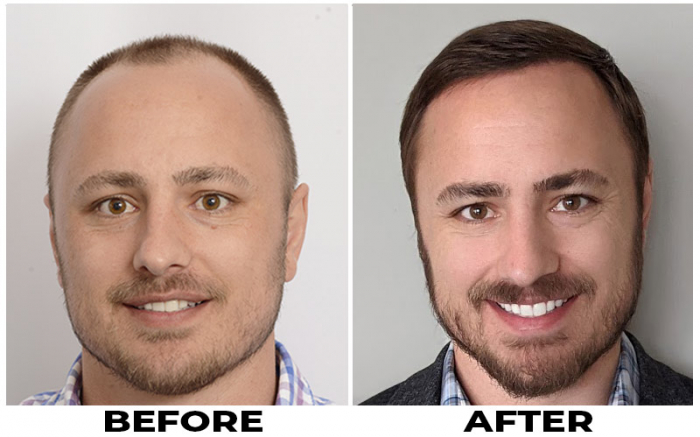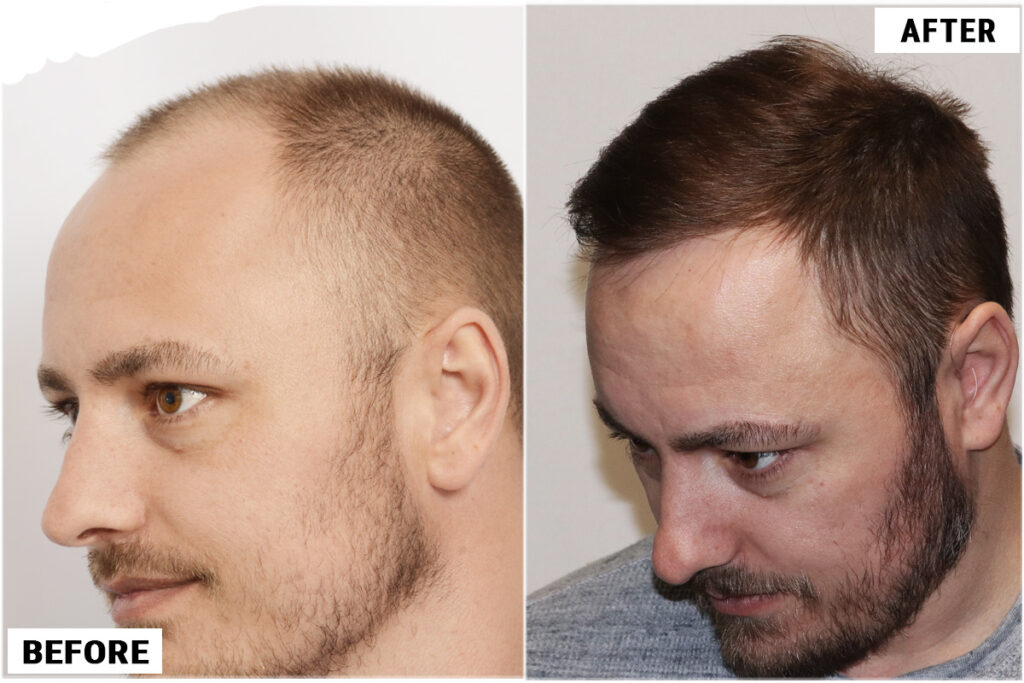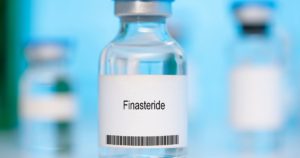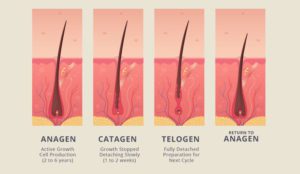For years, I have maintained that hair loss due to androgenetic alopecia is an aging process. Individuals experiencing hair loss at a young age invariably have hair that is biologically older than their chronological age.
Epigenetic testing is a way to measure this “hair age” and to understand the hidden factors accelerating hair follicle aging. In this article, I explore:
- What epigenetic testing is,
- How it relates to hair health,
- How knowing your hair’s true age can guide personalized treatments.
Follicles Age Faster Than Skin
Hair follicles are one of the few organs in your body that routinely regenerate themselves. A single follicle might cycle through 10-30 growth cycles in a lifetime, producing a new hair each time.
This high rate of turnover may come at a cost: hair follicle cells can accumulate aging changes faster than cells in some other tissues.
There are a few reasons why hair follicles may biologically age faster than the rest of the body, and those include:
- Ultraviolet (UV) radiation
- Psychological stress
- Hormonal imbalances
- Inflammation and autoimmune reactions
- Oxidative stress and free radicals
Hair follicles age earlier than the surrounding skin in PHL – pattern hair loss that affects 50% of men by the age of 50 years, and up to 70% of all males in later life, as stated in Trüeb’s research.
The article presents strong supporting evidence that miniaturizing hair follicles in PHL undergo early or accelerated aging-like changes, including premature cellular senescence in dermal papilla cells as well as oxidative stress and DNA damage.

How Epigenetic Testing Helps with Hair Loss?
Understanding that hair follicles can age (and sometimes why they age faster) sets the stage for interventions – if we can measure a follicle’s true biological age, perhaps we can tailor treatments to slow or even reverse that aging process.
For instance, a 35-year-old individual might have hair follicles that test with an epigenetic age of 50 (hypothetically) – indicating that something is causing their hair to age faster.
This could point doctors toward looking at chronic inflammatory conditions, high stress, or lifestyle factors that need correction. It essentially validates that the hair loss isn’t just genetic destiny but has an age-related component that might be modified.
Conversely, if someone’s hair age comes back equal to or younger than their actual age, then their hair loss might be more purely genetic or hormonal, and other interventions (like DHT blockers or transplantation) might be prioritized.

Meet TruDiagnostic®: The Next-Gen Biological-Age Test
How do we measure something like a follicle’s true biological age?
In our clinic, we utilize TruDiagnostic® testing, which sets the foundation for personalized strategies to manage and slow down your biological aging.
Unlike genetic testing, which examines the DNA sequence, epigenetic testing looks at the modifications that regulate gene expression without altering the DNA sequence. Various factors, including lifestyle, environment, and age, can influence these modifications.
At its core, TruDiagnostic epigenetic testing focuses on DNA methylation, a critical epigenetic marker. Doing so, it provides a comprehensive overview of an individual’s epigenetic profile.
DunedinPACE
TruDiagnostic uses third-generation biomarkers called the DunedinPACE (Pace of Aging computed from the Epigenome) to measure the rate of aging and provide insights into influencers on the aging process.
DunedinPACE was developed as a next-generation measure of biological aging, improving on the original DunedinPoAm model.
Unlike traditional DNA methylation clocks (such as Horvath, Hannum, PhenoAge, or GrimAge) that estimate biological age as a fixed number, DunedinPACE quantifies the rate at which aging is occurring — offering a more dynamic and clinically useful perspective.
Key advantages, as detailed in the eLife publication, include:
- Pace, not just age
DunedinPACE captures how quickly biological decline is happening right now. This makes it more responsive to interventions and more suitable for tracking change over time — which is critical for evaluating treatment impact in clinical settings. - High test-retest reliability
Among all clocks evaluated, DunedinPACE demonstrated some of the highest test-retest reliability, comparable to GrimAge and more consistent than Horvath, Hannum, and PhenoAge models. This reliability is crucial for measuring within-person changes, particularly in clinical trials or treatment monitoring. - Stronger predictive validity
In comparisons across multiple datasets, DunedinPACE effect sizes were equal to or larger than those for GrimAge and significantly larger than for earlier-generation clocks when predicting important health outcomes — including disease risk, physical decline, and mortality. - Incremental predictive power
DunedinPACE added unique value even when used alongside existing clocks. It improved the prediction of morbidity and functional decline beyond what GrimAge or PhenoAge alone could provide, reinforcing its value as a complementary biomarker. - Sensitivity to early-life stressors
The measure has shown the ability to detect faster aging in individuals with adverse childhood experiences, even at relatively young ages. This suggests it captures environmental and social factors that shape long-term biological outcomes. - Conceptual and empirical distinction
DunedinPACE is not just a refinement of previous clocks — it represents a conceptually distinct approach, grounded in long-term, longitudinal data from the Dunedin Study cohort. Its development was explicitly focused on modeling the rate of physiological decline across multiple organ systems over time.
In short, DunedinPACE utilizes a broader range of epigenetic data and incorporates advanced algorithms to provide a more detailed and nuanced picture of aging.
Traditional clocks are less sensitive to short-term changes and may not show the immediate effects of lifestyle interventions. DunedinPace detects changes in the rate of aging due to lifestyle modifications, which is valuable for monitoring the effectiveness of health interventions and anti-aging treatments.
What Does TruDiagnostic Epigenetic Testing Measure?
The primary areas of TruDiagnostic testing include:
- Biological Age: Measures the biological age of cells compared to chronological age.
- Immune System Aging: Evaluates the state of the immune system, indicating potential vulnerabilities or strengths.
- Telomere Length: This measure assesses the length of telomeres, which are protective caps on chromosomes that shorten with age.
- Risk for Chronic Diseases: This section identifies potential risks for diseases such as cancer, cardiovascular diseases, and metabolic disorders.
- Type 2 Diabetes Risk
- Inflammation
- Mitotic Clock
- OMICm Age
- DunedinPACE aging rate
- Cell Immune Markers
- Fitness Age (VO2 max, FEV1, Grip Strength, and Gait Speed)
- Smoking and Drinking Influence and History
- Weight Loss Response Report
- Extrinsic and Intrinsic Age
Key Benefits of TruDiagnostic Epigenetic Testing
1. Personalized Health Insights: The test provides us with a detailed understanding of an individual’s biological aging process, helping shape personalized lifestyle and health interventions.
2. Early Detection of Disease Risk: We’re able to identify early markers for chronic diseases, allowing for proactive management and prevention strategies.
3. Monitoring Health Interventions: We can track the effectiveness of lifestyle changes, supplements, and medications on biological aging.
4. Enhanced Wellness: We receive insights into immune function, helping improve overall health and wellness.
5. Research and Development: Testing contributes valuable data to ongoing research in aging and epigenetics, advancing scientific understanding.
Using Pace-of-Aging Scores to Guide Hair Restoration at ForHair
We currently use pace-of-aging data to:
Tailor CIT® Graft Counts
ForHair’s proprietary CIT® (Cole Isolation Technique) allows us to perform follicular unit extraction (FUE) with minimal damage and maximum yield.
By understanding how quickly a patient’s follicles are aging, we can adjust graft planning accordingly — balancing density goals with long-term graft survival.

Select Supportive Treatments
Patients showing signs of accelerated follicular aging may be more likely to benefit from regenerative therapies such as PRP with CRP + Acell or Alma TED.
These treatments are selected not based on guesswork, but based on individual biological need — for example, where there is evidence of inflammation-driven or stress-related follicular decline.
Monitor Progress Over Time
Pace-of-aging scores provide a way to assess how a patient’s biology is responding to treatment. When combined with trichoscopy and other clinical evaluations, retesting can help refine the treatment plan and adjust timing or modality if needed.
From Test Kit to Treatment: Forhair’s Personalized Plan
At ForHair, we use epigenetic testing as a clinical tool to better understand the underlying drivers of hair loss — particularly those related to biological aging, inflammation, and immune system function.
The process is straightforward for patients and is designed to produce actionable insights that support more targeted interventions.
What does it look like in practice?
1. Sample Collection
Patients begin by collecting a small blood sample at home. This can be done using a standard finger-prick kit (typically 10–15 drops of blood) or an alternative self-collection device, such as the Tasso+.
Both methods are minimally invasive and include clear step-by-step instructions.
2. Sample Submission
The collected sample is returned by mail to the laboratory using pre-packaged materials. Once received, it is processed under secure and controlled conditions to maintain sample integrity throughout the analysis.
3. DNA Extraction and Methylation Analysis
In the lab, DNA is extracted from the blood sample and analyzed for patterns of DNA methylation — one of the most reliable markers for measuring biological age and age-related changes in gene regulation.
This step uses next-generation sequencing and proprietary algorithms to assess how key systems in the body, including the immune and inflammatory pathways, may be contributing to hair follicle aging.
4. Comprehensive Reporting
Patients receive a detailed report, typically within two weeks. It includes metrics such as epigenetic age, telomere length, immune system function, and signs of systemic inflammation.
These metrics provide a more complete picture of how the body — and the hair follicles in particular — may be aging compared to chronological expectations.
5. Interpretation and Clinical Integration
Optional consultations with ForHair’s clinical team allow patients to review their results in context.
The goal is not simply to explain findings, but to use them to inform decisions about treatment — including whether interventions such as PRP, stem cell therapy, lifestyle modifications, or pharmacological options are appropriate based on the biological profile.
Order your kit ahead of your free consult
CONTACT US FOR DETAILS
Lifestyle Tweaks to Slow Follicular Aging
Based on a patient’s epigenetic profile, we may recommend practical, evidence-based changes to help slow down the biological aging of hair follicles.
These suggestions are tailored to address the systemic factors most commonly linked to follicular decline:
- Improve dietary quality
Emphasize anti-inflammatory, antioxidant-rich foods (e.g. greens, berries, oily fish); correct common deficiencies like iron, vitamin D, and zinc. - Manage chronic stress
Use structured stress-reduction methods such as mindfulness, CBT, or breathwork to lower cortisol and support hair cycle stability. - Enhance sleep routines
Aim for consistent, high-quality sleep; limit evening screen time; address underlying sleep disturbances if present. - Reduce environmental exposures
Minimize contact with pollutants and tobacco smoke; consider antioxidant support if exposure is unavoidable. - Maintain regular physical activity
Engage in moderate exercise to lower inflammation and support hormonal balance, avoiding extremes that may increase physical stress.
FAQ
How accurate is epigenetic testing for hair aging?
Epigenetic testing, particularly when using advanced tools like DunedinPACE, offers a high degree of accuracy and reliability.
Unlike first-generation biological age clocks, DunedinPACE is designed to measure the current rate of aging, not just accumulated age — making it more responsive to subtle biological shifts.
What does the test actually tell me about my hair loss?
The test doesn’t look at hair loss genes directly — instead, it provides a broader view of how your body (and by extension, your hair follicles) are aging.
If your epigenetic age is higher than your chronological age, or if you show signs of accelerated aging in specific biological systems (like immune regulation or inflammation), that can help explain why hair follicles are miniaturizing or becoming less active.
This adds context to other clinical evaluations and helps inform treatment decisions.
How much does epigenetic testing cost?
At ForHair, we offer TruDiagnostic testing as part of a comprehensive evaluation, which includes sample collection, laboratory processing, detailed reporting, and optional clinical consultation.
Pricing is available on request and reflects the scope of testing (including over a dozen biomarkers, aging metrics, and biological risk assessments).
We recommend this test for individuals seeking a more data-driven, long-term plan for managing hair loss and overall aging.
Is this a one-time test, or should I retest in the future?
Epigenetic testing can be done as a baseline assessment, but many patients benefit from retesting every 6 to 12 months.
Because methylation patterns can change in response to lifestyle interventions, supplementation, or treatments like PRP and stem cell therapy, retesting allows us to measure whether those interventions are meaningfully impacting your rate of aging.
If you’re actively trying to slow follicular decline, retesting can help confirm progress and refine your strategy.
Can lifestyle changes really influence the results?
Yes. Unlike genetic traits, which are fixed, epigenetic markers are dynamic and influenced by environment, behavior, and biology. That’s what makes this kind of testing valuable — it can track how your internal systems respond to interventions over time.
Improvements in sleep, stress management, nutrition, and inflammation control have been shown in clinical studies to alter epigenetic age and aging rate, which may reflect positively in your results.
Ready to See Your Hair’s True Age?
Understanding the biological age of your hair follicles isn’t just about curiosity — it’s about having the right information to make more informed decisions about your health and hair restoration strategy. At ForHair, we use epigenetic testing not as a trend, but as a clinical tool that helps us tailor treatments based on measurable, underlying factors.
If you’re experiencing early hair thinning or seeking more clarity around treatment options, the TruDiagnostic test offers a way to assess where your biology stands today — and how it may be influencing your hair.
| Contact our team directly to order a TruDiagnostic kit or discuss how we use these results in treatment planning. REACH OUT |
Sources:
- Trüeb RM. Understanding Pattern Hair Loss-Hair Biology Impacted by Genes, Androgens, Prostaglandins, and Epigenetic Factors. Indian J Plast Surg. 2021 Dec 14;54(4):385-392. doi: 10.1055/s-0041-1739252. PMID: 34984074; PMCID: PMC8719969.
- Belsky, Daniel W, et al. “DunedinPACE, a DNA Methylation Biomarker of the Pace of Aging.” ELife, vol. 11, 14 Jan. 2022, elifesciences.org/articles/73420.pdf, https://doi.org/10.7554/elife.73420.
- Aging-US. “Aging: Clinical Trial on Potential Reversal of Epigenetic Age Using a Diet and Lifestyle.” Aging-Us.com, Aging-US, 27 May 2021, www.aging-us.com/news-room/clinical-trial-on-potential-reversal-of-epigenetic-age-using-a-diet-and-lifestyle. Accessed 30 May 2025.








